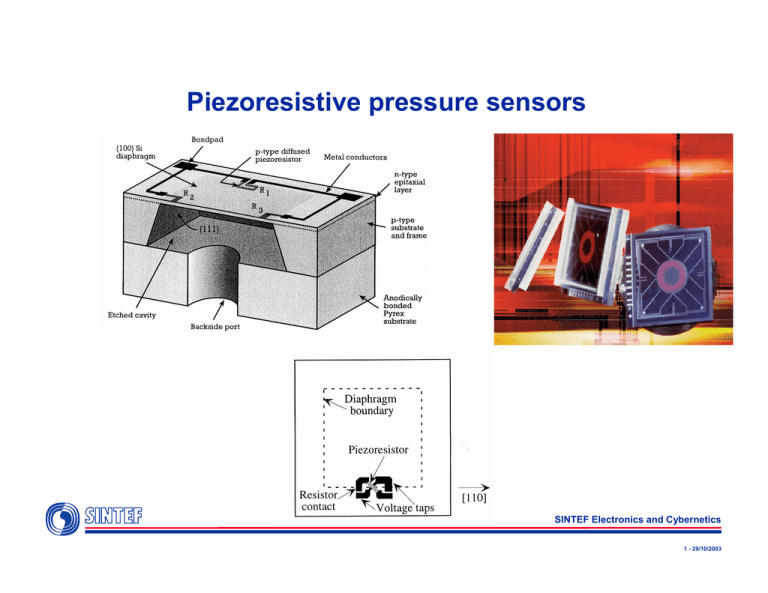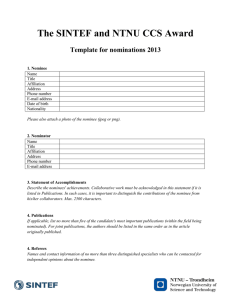Piezoresistive pressure sensors
advertisement

Piezoresistive pressure sensors SINTEF Electronics and Cybernetics 1 - 29/10/2003 Two sensing principles y Piezoresistive y measure mechanical stress in doped resistor-area y diaphragm pressure sensor y bending beam due to yvolume forces (e.g. acceleration) yend force (e.g. protein attached) y capacitive y measure deflection (distance to other capacitor plate) y diaphragm pressure sensor y bending beam due to yvolume forces (e.g. acceleration) yend force (e.g. protein attached) y Comb-structure (mass and large capacitor) attached to beam (flexible mechanical element) is a common structure SINTEF Electronics and Cybernetics 2 - 29/10/2003 Relation between stress and strain in a coordinate system with axes equivalent to the axes of the unit cell F σ x C11 C12 σ y C12 C11 σ z C C12 12 = τ yx 0 0 0 τ zx 0 τ xy 0 0 C12 0 0 0 C12 0 0 0 C11 0 0 0 0 C44 0 0 0 0 C44 0 0 0 0 C44 ε x ε y ε z γ yz γ zx γ xy SINTEF Electronics and Cybernetics 3 - 29/10/2003 Small deflections Beam equation, plate equation y Beam equation: d 4w q = 4 dx EI F y Plate equation: ∂4w ∂4w ∂4w D ( 4 + 2 2 2 + 4 ) = P ( x, y ) ∂ x∂ y ∂y ∂x p y Find displacement and stress SINTEF Electronics and Cybernetics 4 - 29/10/2003 General: Finite Element Analysis y Solve Navier’s equation (partial differential equation) r 2r (λ + µ )∇(∇ ⋅ u ) + µ∇ u = 0 y Divide domain into elements y Approximation of function (solution to partial differential equation) over domain y Simple function over each element (linear, parabolic) y Connect elements at nodes SINTEF Electronics and Cybernetics 5 - 29/10/2003 Example: beam with end load SINTEF Electronics and Cybernetics 6 - 29/10/2003 Resistor change in metal strain gauges Mainly due to change of resistor FORM (geometric effect) L F L+∆L a a R0=ρ L/a2 ∆a/a =-ν ∆L/L a+∆a R=R0+R0 ∆L/L+3R0∆a/a ∆R/R ≈ 2 ∆L/L ∆R/R ≈ 2 ε ν=0.3 SINTEF Electronics and Cybernetics 7 - 29/10/2003 For silicon: large RESISTIVITY change with stress (not mainly a geometric resistor-change factor) Metall: Silisium: + - + - + - + - + - + - + - + - + - + - + - + - + - + - + - + - + - + - + - + - ∆R/R ≈ 2 ε + - - + ∆R/R ≈ 90 ε SINTEF Electronics and Cybernetics 8 - 29/10/2003 Electronics (Chapter 14.1 - 14.4) Doped resistors Define a p-type circuit in a n-type wafer Wafer must be at positive potential relative to the circuit SINTEF Electronics and Cybernetics 9 - 29/10/2003 The resistivity changes with the mechanical stress y E - electric field, three components y j - current density, three components y ρ0 - resistivity, unstressed silicon y When mehanical stress is applied, the resistivity changes depending on the stress in different directions d1 d 6 d 5 j1 E1 j1 E = ρ j + ρ d d d j 0 2 0 6 2 4 2 2 d 5 d 4 d 3 j3 E3 j3 SINTEF Electronics and Cybernetics 10 - 29/10/2003 Silicon: Three independent piezoresistive coefficients y Example of piezoresistive coefficients: y doping: p-type y sheet resistivity: 7.8 Ωcm y value of Π11= 6.6 10-11 Pa-1 y value of Π12=-1.1 10-11 Pa-1 y value of Π11= 138 10-11 Pa-1 d1 Π11 Π12 Π12 0 0 0 d Π Π11 Π12 0 0 0 2 12 d 3 Π12 Π12 Π11 0 0 0 = 0 0 Π 44 0 0 d 4 0 d 0 0 0 0 Π 44 0 5 d 6 0 0 0 0 0 Π 44 σ x σ y σ z τ yx τ zx τ xy SINTEF Electronics and Cybernetics 11 - 29/10/2003 Dependence of piezoresistivity on doping SINTEF Electronics and Cybernetics 12 - 29/10/2003 Long, narrow resistors y Pre-calculated “piezocoefficients” that enables the designer to calculate the resisivity change for a long, narrow resistor y Often given for a resistor that is placed in the <110> direction y Transverse and longitudinal coefficients ∆R = π lσ l + π tσ t R SINTEF Electronics and Cybernetics 13 - 29/10/2003 Resistors in <110> direction y Much used direction for piezoresistors y Pre-calculated longitudinal and transverse piezo-coefficients y σ positive: tensile stress y σ negative: compressible stress y π positive: increased resistivity with tensile stress y π negative: decreased resistivity with tensile stress y p-type silicon: π44 dominerer π l = 1 / 2(π 11 + π 12 + π 44 ) π t = 1 / 2(π 11 + π 12 − π 44 ) ∆R π 44 ≈ (σ l − σ t ) R 2 SINTEF Electronics and Cybernetics 14 - 29/10/2003 Piezoresistive sensing applications Trykksensorer Veieceller Akselerometer SINTEF Electronics and Cybernetics 15 - 29/10/2003 Beam accelerometer y Long resistors in <110> direction y Piezoresistance coefficients SINTEF Electronics and Cybernetics 16 - 29/10/2003 Placement of piezoresistors on diaphragm Over/under konfigurasjon er ikke praktisk i silisium. Men vi kan snu retningen på motstandene SINTEF Electronics and Cybernetics 17 - 29/10/2003 Piezoresistor placed normal to diaphragm edge y y y y y Apply pressure from above Diaphragm bends down Piezoresistor is stretched longitudinally σl is positive Rough argument for mechanical stress in transversal direction: stress must avoid contraction: σt= σlν y Reasonable arguments indicates that transverse stress is compressible y σt is then negative y Change in resistance: ∆R1 / R1 = (π l − νπ t )σ l y (πt is negative) y Resistance increases SINTEF Electronics and Cybernetics 18 - 29/10/2003 Piezoresistor placed parallel to diaphragm edge y y y y y y y Apply pressure from above Diaphragm bends down Piezoresistor is stretched transversally σt is positive Rough argument for mechanical stress in longitudinal direction: stress must avoid contraction: σl= σtν Reasonable arguments suggest compressible stress in longitudinal dir. Change in resistance: ∆R2 / R2 = (π t −νπ l )σ t y (πt is negative) y Resistance decreases SINTEF Electronics and Cybernetics 19 - 29/10/2003 Membrane pressure sensor SINTEF Electronics and Cybernetics 20 - 29/10/2003 Wheatstone bridge circuit y <100> direction π l = 71.8 π t = −66.3 σ positive, tensile stress σ negative, compressible stress R R V0 =Vs 2 − 3 R2 + R1 R3 + R4 R1 = R1 − ∆R R2 = R2 + ∆R R3 = R3 − ∆R R4 = R4 + ∆R ∆R V0 =Vs R SINTEF Electronics and Cybernetics 21 - 29/10/2003 Cantilever with piezoresistors y length 200 µm y width 20 µm y thickness 5 µm y point load at free end y y y y p-type piezoresistor length 20 µm width 2 µm depth 0.2 µm y ∆R/R = πl σl =0.02 SINTEF Electronics and Cybernetics 22 - 29/10/2003 Motorola MAP sensor SINTEF Electronics and Cybernetics 23 - 29/10/2003 Potential across piezoresistor Electric field in transverse direction SINTEF Electronics and Cybernetics 24 - 29/10/2003 Coventor tutorials-choose one y In files mems_analy.pdf and mems_supp.pdf y y y y Mirror design (electrostatic forces) Beam simulation analysis (pull-in) Modal and harmonic analysis (resonant frequencies, modal shapes) Temperature analysis (temperature distribution, different coefficients) y y y y y y y MemHernry (magnetic sensor) MemPackage (thermal and mechanical effects) MemPZR (piezoresistors) MemETherm (Joule heating, thermal expansion) AutoSpring (Extract spring constants) MemDamping (Squeeze film, slide damping) MemTrans (Transient analysis) SINTEF Electronics and Cybernetics 25 - 29/10/2003 SINTEF Electronics and Cybernetics 26 - 29/10/2003 SINTEF Electronics and Cybernetics 27 - 29/10/2003 SINTEF Electronics and Cybernetics 28 - 29/10/2003 SINTEF Electronics and Cybernetics 29 - 29/10/2003 SINTEF Electronics and Cybernetics 30 - 29/10/2003


